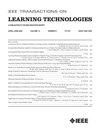Attention Level Evaluation in Children With Autism: Leveraging Head Pose and Gaze Parameters From Videos for Educational Intervention
IF 4.9
3区 教育学
Q2 COMPUTER SCIENCE, INTERDISCIPLINARY APPLICATIONS
引用次数: 0
Abstract
In children with autism spectrum disorders (ASDs), assessing attention is crucial to understanding their behavioral and cognitive functioning. Attention difficulties are a common challenge for children with autism, significantly impacting their learning and social interactions. Traditional assessment methods often require skilled professionals to provide personalized interventions, which can be time consuming. In addition, existing approaches based on video and eye-tracking data have limitations in providing accurate educational interventions. This article proposes a noninvasive and objective method to assess and quantify attention levels in children with autism by utilizing head poses and gaze parameters. The proposed approach combines a deep learning model for extracting head pose parameters, algorithms to extract gaze parameters, machine learning models for the attention assessment task, and an ensemble of Bayesian neural networks for attention quantification. We conducted experiments involving 39 children (19 with ASD and 20 neurotypical children) by assigning various attention tasks and capturing their video and eye patterns using a webcam and an eye tracker. Results are analyzed for participant and task differences, which demonstrate that the proposed approach is successful in measuring a child's attention control and inattention. Ultimately, the developed attention assessment method using head poses and gaze parameters opens the door to developing real-time attention recognition systems that can enhance learning and provide targeted interventions.自闭症儿童的注意力水平评估:利用视频中的头部姿势和凝视参数进行教育干预
对于患有自闭症谱系障碍(ASD)的儿童来说,评估注意力对于了解他们的行为和认知功能至关重要。注意力障碍是自闭症儿童面临的共同挑战,严重影响了他们的学习和社会交往。传统的评估方法通常需要熟练的专业人员来提供个性化的干预措施,这可能会耗费大量时间。此外,现有的基于视频和眼动跟踪数据的方法在提供准确的教育干预方面存在局限性。本文提出了一种无创、客观的方法,利用头部姿势和凝视参数来评估和量化自闭症儿童的注意力水平。所提出的方法结合了用于提取头部姿势参数的深度学习模型、提取凝视参数的算法、用于注意力评估任务的机器学习模型以及用于注意力量化的贝叶斯神经网络集合。我们对 39 名儿童(19 名患有 ASD 的儿童和 20 名神经畸形儿童)进行了实验,为他们布置了各种注意力任务,并使用网络摄像头和眼动追踪器捕捉他们的视频和眼动模式。实验结果分析了参与者和任务的差异,证明所提出的方法能成功测量儿童的注意力控制和注意力不集中情况。最终,利用头部姿势和注视参数开发的注意力评估方法为开发实时注意力识别系统打开了大门,该系统可提高学习效率并提供有针对性的干预措施。
本文章由计算机程序翻译,如有差异,请以英文原文为准。
求助全文
约1分钟内获得全文
求助全文
来源期刊

IEEE Transactions on Learning Technologies
COMPUTER SCIENCE, INTERDISCIPLINARY APPLICATIONS-
CiteScore
7.50
自引率
5.40%
发文量
82
审稿时长
>12 weeks
期刊介绍:
The IEEE Transactions on Learning Technologies covers all advances in learning technologies and their applications, including but not limited to the following topics: innovative online learning systems; intelligent tutors; educational games; simulation systems for education and training; collaborative learning tools; learning with mobile devices; wearable devices and interfaces for learning; personalized and adaptive learning systems; tools for formative and summative assessment; tools for learning analytics and educational data mining; ontologies for learning systems; standards and web services that support learning; authoring tools for learning materials; computer support for peer tutoring; learning via computer-mediated inquiry, field, and lab work; social learning techniques; social networks and infrastructures for learning and knowledge sharing; and creation and management of learning objects.
 求助内容:
求助内容: 应助结果提醒方式:
应助结果提醒方式:


